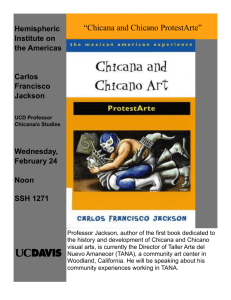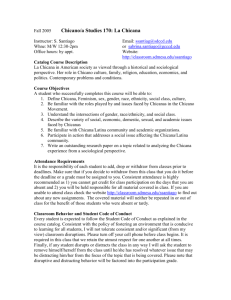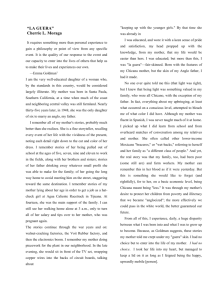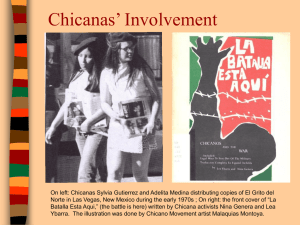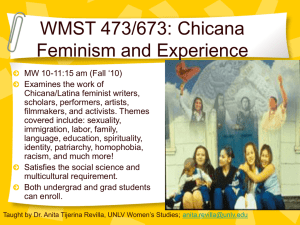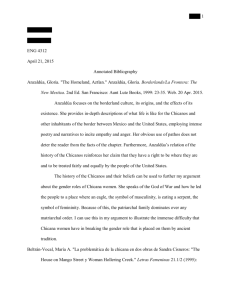Chicanas, World-Travelling, and the Construction of Multiplicitous Selves
advertisement
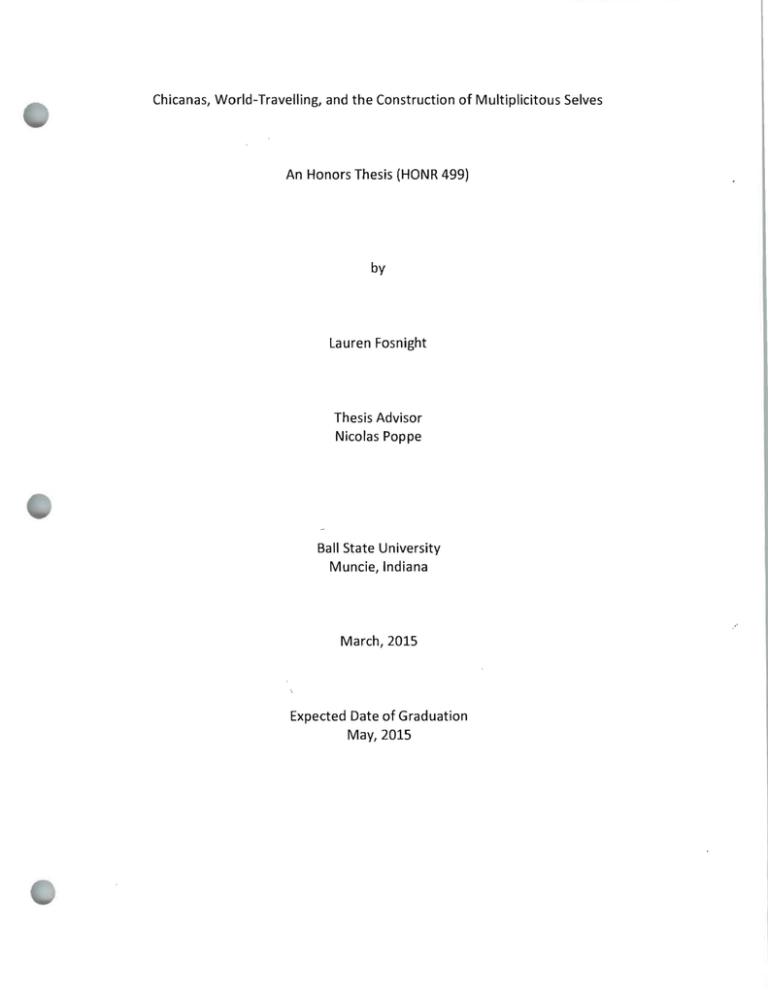
Chicanas, World-Travelling, and the Construction of Multiplicitous Selves An Honors Thesis (HONR 499) by Lauren Fosnight Thesis Advisor Nicolas Poppe Ball State University Muncie, Indiana March, 2015 Expected Date of Graduation May, 2015 2 Abstract , . In this paper, I apply Marfa Lugones' work "Playfulness, 'World'-Travelling, and Loving Perception," to Chicana experiences. I aim to explore the construction and maintenance of multiplicitous selves within different "worlds," or constructed ways of being, that Chicanas experience and inhabit. In doing so, I wish to uncover the ways in which these constructed worlds impact human flourishing, and propose a course of action to take when we find ourselves in a world that limits the "playfulness" of others. 3 Acknowledgements I would like to thank Dr. Nicolas Poppe and Dr. Juli Thorson for advising me throughout this project. Their guidance and encouragement have been great assets in the completion of this thesis, as well as my educational experience at Ball State. 4 "Love is seen not as fusion and erasure of difference but as incompatible with them. Love reveals plurality. Unity - not to be confused with solidarity - is understood as conceptually tied to domination." - Marfa Lugones, "Playfulness, 'World'- Travelling and Loving Perception" In her paper, "World'-Travelling, and Loving Perception,"l Marfa Lugones discusses our ability to travel into different "worlds," or constructed ways of being. She writes, "A 'world' in my sense may be an actual society given its dominant culture's description and construction of life, including a construction of the relationships of production, of gender, race etc. But a 'world' can also be such a society given a non-dominant construction ...As we will see it is problematic to say these are all constructions of the same society. But they are different 'worlds."'2 The focus of her essay is the existence of the outsider - the person who, by necessity, has acquired the ability to flexibly shift between worlds in which she feels at home and those in which mainstream society has constructed her as an "other." Lugones calls the act of shifting between different worlds "travelling" and clarifies that when one travels, one is not simply stepping into new surroundings, but shifting from being one person to being another. 3 While Lugones acknowledges that much of the worldtravelling that members of minority groups do is a compulsory entrance into hostile 1 Marfa Lugones, "Playfulness, 'World'-Travelling, and Loving Perception," Hypatia 2, no. 2 (1987): 3-19. 2lbid., 10. 3lbid., 11. 5 worlds, she prescribes world-travelling as a means of cross-cultural and cross-racial loving. 4 In order to perceive others lovinglyS (to see ourselves in others and cease to view ourselves as completely separate and independent of others), we must allow them to be playful in our world, and we must also feel free to behave playfully with them. Lugones describes loving playfulness as an openness to surprise, to selfconstruction, to being a fool, and to being active and creative. Beings who are playful are not worried about their competence or about acting in a particular way.6 Lugones offers examples of playfulness within a particular world: being normatively happy, a fluent speaker, humanly bonded (connected with others through loving relationships), and sharing a common history with others.? We can be playful, and be perceived playfully, in some worlds while other worlds prevent us from being playful. When we can be playful in one world but not in another, we obtain a double image of the self. 8 That is, we become different people in different worlds. We 4Ibid.,3. SLugones adopts the concepts of arrogant and loving perception from Marilyn Frye's essay, "In and Out of Harm's Way: Arrogance and Love." 6Ibid., 16-17. 7Ibid., 12. 8 Lugones' conception of a double vision of the self parallels W.E.B. Du Bois' concept of double consciousness, which entails looking at oneself through the eyes of others (See Jose Medina, 193). 6 become a plurality o/selves (henceforth referred to as "multiplicitous selves"). We become confused and ambiguous beings.9 While Lugones' paper describes the travelling experience of any "outsider" into mainstream culture, it focuses particularly on her own experience as a woman of color in the U.S. and the failure of love she experiences in the midst of White/Anglo women. She writes that, although women of color can gain the greatest degree of recognition within the dominant cultural framework among White/Anglo women, the bond of gender often does not preserve loving perception across racial and cultural lines. In the worlds of White/Anglo women, women of color are still frequently subordinated, ostracized, and ignored. 1o In order to apply Lugones' concepts within a more localized context, I have chosen to focus my paper specifically on Chicana experiences. By exploring the ways in which multiplicitous selves are constructed and maintained within different worlds into which most Chicanas travel, we can learn how the construction of multiplicitous selves impacts human flourishing. Before exploring the construction of multiplicitous selves, I will define the term "Chicana" as it is to be understood within the framework of this essay and then offer a discussion of the ways in which two worlds, the U.S. public education system and the workforce, are capable of constructing Chicanas as unplayful, thereby stunting their ability to flourish in these environments. 9Ibid., 13-14. lOlbid., 7-8. 7 Part I: Defining Chicana The meaning and connotations of the term "Chicana/o" are fluid and, in certain contexts, highly contestable. The origin of the term is not precisely known. Some researchers have argued that the word stems from the Aztec pronunciation of "Mexicano" (pronounced 'Me-shi-ca-noh' in the Nahuatl language), while others speculate that the word was formed by adding the suffix "ano" to the word "chico" (a young boy),ll or that the term originated as a derogatory term derived from the word "chiquero" (pigsty).12 The term was not officially coined, however, until the Chicano movement of the 1960s and 70S.13 During this period, the term developed connections with the working-class Mexican-immigrant experience and the pride in their mestiza/o ancestry. A woman's self-identification as a "Chicana" came to imply an awareness (conciencia) of the plurality of her unique social position and cultural identity and her possession of a strong connection to her heritage, along with recognition that her perspective, although culturally tied, is different than that of Chicano men. 14 llEdward R. Simmen and Richard F. Bauerle, "Chicano: Origin and Meaning," American Speech 44, no. 3 (Autumn, 1969): 225-226. 12Carmen Tafolla, To Split a Human: Mitos, Machos, y la Mujer Chicana (San Antonio: Mexican American Cultural Center, 1985), 6. 13Gloria Anzaldua, Borderlands/La Frontera: The New Mestiza (San Francisco: Spinsters/Aunt Lute Book Company, 1987),63. 14Tafolla, To Split a Human, 6-7. 8 Today, a broad definition of "Chicana" is a female who resides in the United States and whose ancestors were at one time residents of the Republic of Mexico;15 however, the term carries various connotations within different subcultures and environments. In some regions of the United States, the term Chicana/o may be rejected on the basis of its former use as a derogatory term for the Mexican lower class or its former activist connotations,16 while in other Mexican-American communities, the term is perceived as relatively neutral and is simply not used in common discourse. Others prefer the term because it is nationality-specific, and implies that people of Mexican heritage living in the U.S. are not merely a blend of two cultures, but a unique culture of their own. While terms such as "Chicana/o" and "Latina/o" are preferred in academic circles,17 many U.S. residents of Mexican heritage prefer the label Spanish-American, Hispanic, Spanish, Mexican-American, or they simply do not identify with a national or ethnic label. 18 For the purpose of this paper, I will employ the term Chicana to refer to females of Mexican heritage living in the U.S. due to the word's specificity and its contemporary social connotations. As a female who is not a member of the Chicana community, I do not wish to prescribe that people of Mexican descent living in the U.S. should self­ 15Ibid., 13. 16lbid., 6. 17Patricia Zavella, "Feminist Insider Dilemmas: Constructing Ethnic Identity with 'Chicana' Informants," in Situated Lives: Gender and Culture in Everyday Life 1997, ed. Louise Lamphere, Helena Ragone, and Patricia Zavella (New York and London: Routledge, 1997),68-69. 18Ibid., 62-64. 9 identify as "Chicana/o." Rather, I wish to adopt consistent, transparent terminology to be used throughout this paper. Furthermore, I want to stress that the label "Chicana" is a general one. While the Chicana experience may be unified through ancestry, cultural traditions, and the position of being both a gender and racial minority, their experiences are also rich with diversity and intersectionality. As I employ the terms "Chicana" or "the Chicana experience" to refer to broad social categorizations, I do not intend to equate or reduce a diverse range of individual experiences to a homogenized way of being in the world. Likewise, when I discuss the worlds into which Chicanas travel, I do not mean to say that all Chicanas travel into these worlds, or that the components of these worlds (individual schools and employers) limit Chicanas in the same ways. Rather, I wish to explore the mechanisms that systematically impact the ways in which Chicanas are allowed to, or are prevented from, travelling playfully between worlds, and how these mechanisms can lead to the construction of multiplicitous selves. The collective experiences to which I will refer will not affect the lives of all Chicanas, but will be reflective of macroscopic constructions of race and gender that restrict, force, or impact the mobilization of Chicanas and subsequently their capacity for human flourishing. In the following portion of my paper, I will explore two worlds, the U.S. public education system and the workforce, into which the majority of Chicanas travel, and investigate how the construction of these worlds either fosters or limits playfulness and flourishing. 10 Part II: Chicanas and World-Travelling A. Chicanas and the U.S. Public Education System The first world I will explore is the public education system in the United States. Primary and secondary education is one of the largest factors in determining social mobility; however, "Hispanic" students have the highest dropout rate (15%) of any major racial group in the United States according to a 2012 study by the Pew Hispanic Center. 19 In Chicanas and Chicanos in School: Racial Profiling, Identity Battles, and Empowerment, Marcos Pizarro states that Chicana/os in particular face the highest dropout rate of any major ethnic group in the United States.z o While data for Mexican-American women in particular is difficult to obtain due to the U.S. Department of Education's grouping of Chicanas under the broad category of "Hispanic," the National Center for Education Statistics reports that in 2012, 11.3% of Hispanic females between the ages of 16 and 24 dropped out of high school, compared to 7% of Blacks and 3.8% ofWhites. 21 There are many factors (financial difficulties, lack of support from family members, etc.) that affect a Chicana's success 19 Mark Hugo Lopez and Richard Fry, "Among Recent High School Grads, Hispanic College Enrollment Surpasses that of Whites," Pew Research Center, Sept. 4, 2013, http://www.pewresearch .org/fact-tank/2013/09 /04/hispanic-college­ enrollment-rate-surpasses-whites-for-the-first-time/. 20 Marcos Pizarro, Chicanas and Chicanos in School: Racial Profiling, Identity Battles, and Empowerment (Austin: University of Texas Press, 2005), 1. 21U.S. Department of Education, National Center for Education Statistics, "Percentage of high school dropouts among persons 16 through 24 years old (status dropout rate), by sex and race/ethnicity: Selected years, 1960 through 2012," Digest of Education Statistics Table 219.70 (Washington D.c.: United States Government Printing Office, 2013). 11 in the public school system; however, there are also ways in which some public schools limit Chicanas' success by restricting their ability to be their playful selves. For the majority of Chicanas, the public school system is their first entrance into a world of a significantly different ethnic, cultural, and linguistic composition than their home. While the percentage of white three- and four-year-olds enrolled in prekindergarten was measured at 38% for white children in 1993, only 17% of Hispanic children of the same age range attended prekindergarten. 22 For the many young Chicanas who receive no formal schooling prior to entering kindergarten, the strict rules, linguistic barriers, cultural differences, and covert discrimination of the public school system can make it a particularly daunting and challenging space to inhabit. These challenges limit a Chicana's ability to speak freely, to form bonds with her teachers and classmates, to feel intelligible - to be her playful self. One of the largest barriers to a Chicana's ability to exercise playfulness, creativity, and active involvement in the classroom is language. Language has long been used as a means to segregate Chicana/o students from Anglo students, and has both intentionally and unintentionally restricted the active participation of Chicana/os and their families in the education system. During the first five decades of the twentieth century, Chicano families fought against the assignment of Chicana/o students to inferior, segregated schools based on students' primary language. In the case of Del Rio (rX) Independent School District v. Salvatierra (1930), 22U.S. Department of Education, National Center for Education Statistics, liThe Educational Progress of Hispanic Students," NCES 95-767, (Washington D.C.: United States Government Printing Office, 1995), 2. 12 the Texas Court of Civil Appeals ruled that the "special language needs" of Chicana/o children justified their assignment to segregated schools.23 The first victory against discrimination on the pretense of language was Mendez et al v. Westminster School District et al (1946), which ruled the segregation of Chicana/o students to be unconstitutional and ordered that they be integrated into "American" schools (this decision was partially due to the fact that the judge deemed Chicana/o students "white").24 The integration of Chicana/os into the mainstream education system, however, did not erase a large portion of the obstacles that Chicana/os faced in achieving educational success or in overcoming the limits of marginalization. For the majority of the twentieth century, many schools in the Southwest enforced a "No Spanish" mandate, which not only restricted Spanish as a language of instruction, but also a language of use within the home. 25 Since the 1960s, Chicano and Latino families have fought numerous battles against English-only legislation and educational practices. 26 Despite numerous studies that show that allowing students 23Victoria-Maria MacDonald, "Demanding their Rights: The Latino Struggle for Educational Access and Equity," in American Latinos and the Making of the United States: A Theme Study, National Park Service, 312, http://www.nps.gov /latino /latinothemestudy/pdfs/EducationJinaLweb. pdf. 24Ibid., 316. 25Tafolla, To Split a Human, 63. 26Luis Urrieta, "Chicana/o Activism and Education: An Introduction to the Special Issue," Pedagogies of Trans/formation B7, no. 4 (2004): 2-5. 13 to develop their home language in school helps students learn English,27 politicians have convinced many voters that heritage language instruction 28 hinders academic progress. 29 In reality, a lack of heritage language education in schools hinders students' ability to be playful, to be at ease, and to learn. Although bilingual education has made great strides in recent years, its effective implementation continues to be a work in progress. The backlash against bilingual education is not the only factor that is capable of linguistically ostracizing Chicanas within the school system. In addition to the linguistic duality developed by speaking Spanish at home and often speaking English in the classroom, Chicanas also receive conf1icting messages about the acceptability of the variety of Spanish they speak. Chicana/o Spanish is as linguistically diverse as Chicana/os are culturally diverse; however, when Spanish is instructed in primary and secondary schools (whether in a bilingual education class for heritage speakers or a Spanish class aimed toward students' whose primary language is English), it is often instructed according to the rules of the Real Academia Espanola, and thus teachers adopt a prescriptive approach toward grammar and vocabulary. These linguistic limitations can cause Chicanas to view 27Tafolla, To Split a Human, 68. 28Heritage language instruction in schools refers to a culturally sensitive means of teaching a language that a student speaks at home when that language is different than the dominant language spoken in a society. 29Urrieta, "Chicana/o Activism and Education," 5. 14 their language as "bad/l or "incorrect./l3o As Aixa Said-Mohand, a specialist in bilingual education for heritage learners, states, "Heritage language students bring to the classroom their own 'linguistic baggage.' If teachers don't address these issues, they may endlessly remark, 'no se dice as!.' It is critical therefore, that HL classroom activities focus on dialectal variation, which can empower heritage language students to communicate with a diverse Spanish-speaking population." 31 When language teachers do not adapt their teaching style to suit the unique situatedness of heritage speakers, Chicanas may feel as if, not just their language, but they themselves do not belong in the classroom. With this limit to linguistic playfulness comes the awareness that they do not fit completely within the dominant cultural framework. This awareness can prompt what Lugones calls a double vision of the self; not only do Chicanas develop an awareness that they are perceived as the "other,/I but they begin to view themselves through the lens of dominant culture (as an aberration from the "norm/l). This double vision aids in the construction of multiplicitous selves by causing Chicanas to become unplayful beings at school while maintaining their playful selves in other environments. This confusing and divided state results in what Lugones refers to as being "ambiguous./I According to Chicana scholar Gloria Anzaldua, Chicano varieties of Spanish are characterized by slang anglicisms, or "pochismos,/I the elimination of certain 30Aixa Said-Mohand, "The Teaching of Spanish as a Heritage Language: Overview of What We Need to Know as Educators," Porta Linguarum, no. 16 (2011): 93. 31Ibid., 94. 15 consonants, such as the "d" when it appears between vowels ("mojado"j"mojao"), the elimination of certain initial and final syllables ("estar"j"tar"), and the use of archaisms that have evolved out of most dialects of Spanish.32 These differences, and others, make the varieties of Spanish spoken by Chicana/os substantially different than the Spanish taught in textbooks. In the educational experience of many Chicana/os, the discrepancies between their home language and more "formal" Spanish paint their native tongue as illegitimate and their use of Chicano Spanish is often discouraged within schools. 33 Outside the classroom, however, Chicana/os who don't speak Chicano Spanish risk being classified as agrindadas/os. 34 The internalized belief of a Chicana that she speaks both Spanish and English poorly can make her ashamed of her speech, and more afraid to speak in the classroom. In Borderlands/La Frontera, Anzaldua describes her experience as a deslenguada, one who speaks with a feeling of shame: "Pena. Shame. Low estimation of the self. In childhood we are told that our language is wrong. Repeated attacks on our native tongue diminish our sense of self. These attacks continue throughout our lives."35 Not all schools teach or promote "prestige dialects" of Spanish, but those that intentionally or inadvertently treat Chicano Spanish as an aberration of the Spanish language (or offer no Spanish language or cultural classes that cater to heritage learners), silence Chicanas. Through the silence imposed on them by the Anglo 32Anzaldua, Borderlands/La Frontera, 56-57. 33Ibid., 59. 34Ibid., 58. 35Ibid., 58. 16 educational framework, Chicanas are constructed within the school as being reserved, uninterested, and unplayful. In addition to language discrimination, cultural differences and distorted expectations can also have a large role in constructing Chicanas as unplayful within schools. According to Carmen Tafolla, a founder of the Chicana literary movement, American schools often place strong emphasis on competition and individual success, rather than community. Not only do competition and individualism clash with Chicano cultural values, but they can be particularly intimidating forces for Chicanas, who, as females, are often socially trained to avoid hostility and intense competition with their male peers.36 Another aspect of Chicano culture that schools may neglect to properly understand is the role of family in the lives of Chicana students and the ways in which Chicano families view the role of educators. As Tafolla writes, extended family plays a much more central role in Chicano culture, and the importance of family events such as weddings, illnesses, etc. are highly stressed. When a Chicana student must be absent from school to attend these events or to be present for a family member in need, her absence from school is often not excused and is deemed truancy,37 Lionel Sosa, CEO of Mexicans and Americans Thinking Together, writes that the families of Chicana students may also seem uninterested in their children's education because ofthe authority they grant to school administrators. Authority is 36Tafolla, To Split a Human, 68-69. 37Ibid., 70. 17 highly respected in Chicano culture, and parents often feel it is not their place to be highly involved in their child's education because they see teachers and school administrators as members of authority who should have primary control over their children's education. 38 Cultural differences such as these often cause teachers to mistake Chicanas and their families as being unmotivated and uninterested in their children's education, and as a result, educators lower their expectations for Chicana/o students. 39 These lowered expectations have a lasting impact on the success of Chicana students. Marcos Pizarro, author of Chicanas and Chicanos in School, writes, "When a Chicana student is psychologically assaulted by a teacher, for example, the effect can become such a great distraction for the student that she sees no possibility of resisting what she has learned is the inevitability of her failure."4o There are several other factors that construct Chicanas as unplayful within the setting of certain primary and secondary schools (Le. the low representation of Chicanas in textbooks and literature, the lack of Chicana/o staff at schools with large Chicana/o populations, the "red tape" that prevents Chicano families from obtaining the educational resources they need). The conflicting linguistic and cultural expectations between school and home life do not merely create dissonance in the lives of Chicanas, but force Chicanas to become different people when they set foot 38Lionel Sosa, "The Unspoken Reasons for Hispanic Undereducation," Journal ofHispanic Higher Education 1, no. 1 (2002): 89. 39Marcos Pizarro, Chicanas and Chicanos in School, 94. 40Ibid., 98. 18 on school grounds. Their forced transformation into unplayful selves not only gives them a dual-vision of themselves of the kind Lugones describes, but also helps render Chicanas invisible in the eyes of administrators, teachers, and classmates. When students are marginalized in this way, it becomes more difficult for them to travel into the worlds of students of different backgrounds, and students from other cultural backgrounds become less likely to travel into the Chicana's world with a loving perception. B. Chicanas in the Workforce While Chicanas and "Hispanas" hold a diverse range of occupations (only 32% of Hispanas were employed in the service industry in 2014, despite the stereotype that the majority of Latinas and Chicanas are service workers),41 they are still one of the lowest paid minorities in the United States. 42 Chicana wages continue to lag behind those of white and black women, and their jobs are often "high-stress, low-status, low-reward, and monotonous."43 While these conditions do have a heavy impact on a Chicana's ability to maintain her playful self in the workplace, another large, but often under-emphasized, obstacle to world-travelling and the ability to maintain playfulness and loving perception is the political climate created by the 41 Department of Labor, Bureau of Labor Statistics, "10. Employed Persons by Occupation, Race, Hispanic or Latino Ethnicity, and Sex," Last modified February 12, 2015, http://www.bls.gov/cps/cpsaatlO.htm. 42Ana Castillo, Massacre a/the Dreamers: Essays on Xicanisma (New York: Plume/Penguin, 1994), 36. 43Tafolla, To Split a Human, 85. 19 gender, ethnic, and class composition of the workplace. As unemployment rises, so does resentment towards Chicanas and Latinas/os in the workforce. 44 The true problem, however, is not whether these groups are displacing other (Anglo) workers, but that they are seen as, and made to feel, less deserving of jobs due to their being Chicana or Latina. Despite the fact that the majority of "Hispanas" are native born or documented residents of the United States, they may still be made to feel as if their place in the workforce is impermissible, as if they exist "illegally" in the workplace. Chicana women may not only endure this sense of "illegality" from their co-workers if they work in a predominantly Anglo or male-dominated environment, but also from other Chicana/oss in their community or home. As Tafolla writes, a Chicana's role as a mother and nurturer is traditionally considered her most important and binding obligation; therefore, her employment outside the home is sometimes looked down upon. Receiving this criticism from both the Anglo and Chicano worlds she inhabits, she may feel as though she is "illegaL" or "mojada," in both worlds. 45 She is caught in a double-bind between needing to be both a financial provider and a full-time nurturer. She obtains a double vision of herself as both deserving/financially obligated and undeserving of travelling into a predominantly Anglo workspace. Anzaldua states that, when this occurs, "The new mestiza copes by developing a tolerance for contradictions, a tolerance for ambiguity ...She learns to juggle cultures. 44Castillo, Massacre o/the Dreamers, 44. 45Tafolla, To Split a Human, 87. 20 She has a plural personality."46 The result Anzaldua discusses here is the construction of multiplicitous selves. The construction of conflicting playful and non-playful selves results in a confusion that stunts human flourishing, in this case, by damaging a Chicana's ability to simultaneously succeed in her job, provide for her family, and feel at ease in her workplace. A Chicana's sense of "illegality" and her playfulness in the workplace has been shown to vary according to the ethnic, gender, and class composition of her workplace. A study by Denise A. Segura examined how the employment experiences and perceptions of mobility of Chicanas and Mexicana immigrants were impacted by their interactions with co-workers of different classes, races, and genders. The study included 20 Chicanas and 20 Mexican-American immigrant women. Fifty-five percent of the women worked in environments in which almost all co-workers were women of color. Forty-two percent worked in jobs where the majority of their co­ workers and supervisors were white women. Only one woman worked with predominantly male co-workers.47 Although wages and working conditions were better for those employed in male-dominated or white-female-dominated work environments, the Chicana and Mexicana informants in jobs dominated by white females reported a high degree of antagonism between themselves and their supervisors/co-workers. This antagonism was often a result of the fact that the 46Anzaldua, Borderlands/La Frontera, 79. 47Denise A. Segura, "Chicana and Mexican Immigrant Women at Work: The Impact of Class, Race, and Gender on Occupational Mobility," Gender and Society 3, . no. 1 (Mar. 1989): 39. 21 Chicana and Mexicana informants entered these jobs as a result of affirmative action. They felt like they did not truly belong and were not able to fully adapt to their workplaces' culture.48 They also reported feeling that cultural divergence from workplace norms (the way they dressed or talked) hindered their ability to network and engage in workplace social activities, which made them feel self-conscious, ostracized, and less capable of obtaining promotions. 49 Chicanas may feel powerless to combat subtle or overt acts of discrimination because they feel as though they lack credibility in the workforce and because being a "troublemaker" conflicts with the Anglo conception and treatment of Chicanas as "passive."50 Anzaldua writes that selfishness and deviance from social norms also tend to be condemned in Chicano culture,51 which can make resistance to harassment and isolation in the workplace more difficult. While Chicanas and Mexicanas in minority-female-dominated jobs did not report feelings of social isolation (a characteristic of unplayfulness) in Segura's study, they possessed fewer concrete promotional opportunities that stunted their ability to flourish in their careers. Many, however, reported feeling upwardly mobile due to the type of position they held. Despite the fact that their jobs paid lower wages than white-female or male-dominated jobs, they compared their jobs to those 48Ibid., 45. 49Ibid., 46-47. 50Denise A. Segura, "Chicanas in White Collar Jobs: You Have to Prove Yourself More," Sociological Perspectives 35, no. 1 (Spring, 1992): 175. 51Anzaldua, Borderlands/La Frontera, 18. 22 of other Chicanas and Mexicanas of similar class status and educational background and felt that they possessed promotional opportunities and occupational benefits based on their success relative to that of other Chicanas/Mexicanas (many of them felt it was rare for a Chicana without a high school diploma to be employed in the formal sector). Their subjective perception of upward mobility and their social connections within the workplace explain why these informants reported being content in their jobs, despite their low pay, dangerous work conditions, and few opportunities for actual advancement. 52 Segura's case study demonstrates the different challenges to playfulness and cross-cultural loving that Chicanas may experience depending on the type of workspace that they occupy. While Chicanas reportedly felt more playful in spaces with female co-workers of color, they lacked the ability to travel into new worlds by way of promotion, and they lacked the opportunity to interact with people of other races and ethnicities, thus limiting their capacity to exercise cross-racial and cross­ cultural loving. Chicanas employed in white-female or male-dominated spaces, however, lacked the ability to interact playfully with their co-workers. Because Anglo women and men either intentionally or unintentionally excluded Chicana employees from their worlds, the act of world-travelling (when Chicanas were permitted to do so, mainly through affirmative action) became an act of self­ preservation, of merely earning a much needed income, rather than a means of understanding and loving the differences in others. The Chicana informants were 52 Ibid., 18. 23 faced with two options: 1) They could be isolated from other races, genders, or classes and maintain a greater degree of their playful selves by working alongside other Chicanas, or 2) they could travel into an Anglo- or male-dominated workspace and be estranged from their playful selves while at work, but have greater promotional opportunities and pay. In discouraging world-travelling, this conflict between being able to be perceived lovingly and seeking greater employment opportunities divides Chicanas, both from their co-workers and from their playful selves, and molds them into "ambiguous beings" by capturing them in the double­ bind between earning a living and maintaining a unified, playful self. This state of ambiguity can lead Chicanas to an acceptance of their dichotomous situation, or a belief that their situation is a natural result oftheir being Chicana. Ana Castillo writes that such internalized oppression contributes to Chicanas being "ideal worker[s] for exploitative operations."53 Conclusion I support Lugones' conclusion that world-travelling is a step toward loving the differences in others while being able to form solidarity with them. In order to do so, Lugones states that we must cease to ostracize, to stereotype, to render others invisible. 54 The first step toward achieving these goals is to recognize the multidimensionality of others and of ourselves. In schools, we must recognize that not all Chicanas speak the type of Spanish that is commonly taught in the classroom, 53Castillo, Massacre o/the Dreamers, 38. 54Ibid.,7. 24 and that varieties of Spanish are diverse between Chicano communities as well. We cannot classify cultural differences as signs of disinterest. We can neither purposefully nor unintentionally stereotype Chicanas as "low-achieving," only to have our low expectations generate lower performance. By recognizing multidimensionality, we can cease to construct Chicanas as "ambiguous" and unplayful beings and create more loving worlds open to travellers. We must make a conscious effort to recognize when we are acknowledging multidimensionality and when we are grafting our stereotypes and arrogant perceptions of others onto them. 55 We must take note of the environments in which we are allowed to be our playful selves and others cannot, in which we are capable of speaking freely, making error, communicating openly, while others are prevented from doing so. When we find that we are permitted to behave playfully and others are not, we must take a closer look at the mode in which we are perceiving. Ifwe perceive lovingly, we recognize multidimensionality. We see that, while others may be constructed as unplayful in a certain environment, they are not inherently unplayful, uninterested, or serious beings. We see that their lack of interaction with co-workers is not a dislike of others, but a result of ostracism. We see that differences in dress or speech are not a lack of professionalism, but indicators of different personalities and cultures. My discussion of how to create more loving worlds and cease constructing others as unplayful by recognizing the multidimensionality in others seems to be 55 In Marilyn Frye's "In and Out of Harm's Way," she describes the belief that everything is either "for me" or "against me" as grafting a being's substance onto oneself. This is a key indicator of arrogant perception (66-67). 25 situated not from the perspective of the outsider, but from those that already playfully inhabit certain worlds. This is because the burden of changing arrogant and unloving perception does not lie with those who are treated with hostility in certain worlds, but with those who perceive others as one-dimensional, unplayful beings - as beings that exist to serve. Our first responsibility is to welcome others into the worlds in which we are playful, and recognize when others cannot maintain that same playfulness. Then, by learning to love multidimensionally, we can cease to construct others as beings they are not (unplayful, unloving, etc.) and become intelligible to one another. Only then can we begin to perceive lovingly. 26 Works Cited Aixa Said-Mohand, "The Teaching of Spanish as a Heritage Language: Overview of What We Need to Know as Educators," Porta Linguarum, no. 16 (2011): 93. Anzaldua, Gloria. Borderlands/La Frontera: The New Mestiza. San Francisco: Spinsters/Aunt Lute Book Company, 1987. Castillo, Ana. Massacre ofthe Dreamers: Essays on Xicanisma. New York: Plume/Penguin, 1994. Department of Labor. Bureau of Labor Statistics. "10. Employed Persons by Occupation, Race, Hispanic or Latino Ethnicity, and Sex." Last modified February 12,2015. http://www.bls.gov/cps/cpsaatl0.htm. Frye, Marilyn, "In and Out of Harm's Way." In The Politics of Reality 52-83. New York: Crossing Press, 1983. Lopez, Mark Hugo and Richard Fry. "Among Recent High School Grads, Hispanic College Enrollment Surpasses that of Whites." Pew Research Center, Sept. 4, 2013 . http://www.pewresearch.org/fact-tank/2013/09 /04/hispanic­ college-enrollment-rate-surpasses-whites-for-the-first-time/. Lugones, Marfa. "Playfulness, IIIWorld'-Travelling, and Loving Perception." Hypatia 2, no.2 (1987): 3-19. MacDonald, Victoria-Maria. "Demanding Their Rights: The Latino Struggle for Educational Access and Equity." In American Latinos and the Making ofthe United 'States: A Theme Study. National Park Service. http://www.nps.gov/latinojlatinothemestudyjpdfsjEducationJinaLweb.pdf. Medina, Jose. The Epistemology of Resistance: Gender and Racial Oppression, Epistemic Injustice, and Resistant imaginations. New York: Oxford University Press, 2013. Pizarro, Marcos. Chicanas and Chicanos in School: Racial Profiling, Identity, Battles, and Empowerment. Austin: University of Texas Press, 2005. Segura, Denise A. "Chicana and Mexican Immigrant Women at Work: The Impact of Class, Race, and Gender on Occupational Mobility." Gender and Society 3, no. 1 (Mar. 1989): 39. Segura, Denise A. "Chicanas in White Collar Jobs: You Have to Prove Yourself More." Sociological Perspectives 35, no. 1 (Spring, 1992): 163-182. 27 Simmen, Edward R. and Richard F. Bauerle. "Chicano: Origin and Meaning." American Speech 44, no. 3 (Autumn, 1969): 225-226. Sosa, Lionel. "The Unspoken Reasons for Hispanic Undereducation." Journal of Hispanic Higher Education 1, no. 1 (2002): 89. Tafolla, Carmen. To Split a Human: Mitos, Machos y la Mujer Chicana. San Antonio: Mexican American Cultural Center, 1985. Urrieta, Luis. "Chicanajo Activism and Education: An Introduction to the Special Issue." Pedagogies of Trans/formation 87, no. 4 (2004): 2-5. U.s. Department of Education. National Center for Education Statistics. "Percentage of high school dropouts among persons 16 through 24 years old (status dropout rate), by sex and racejethnicity: Selected years, 1960 through 2012." Digest of Education Statistics Table 219.70. Washington D.C.: United States Government Printing Office, 2013. U.S. Department of Education. National Center for Education Statistics. "The Educational Progress of Hispanic Students." NCES 95-767. Washington D.c.: United States Government Printing Office, 1995. Zavella, Patricia. "Feminist Insider Dilemmas: Constructing Ethnic Identity with 'Chicana' Informants." In Situated Lives: Gender and Culture in Everyday Life 1997, ed. Louise Lamphere, Helena Ragone, and Patricia Zavella. New York and London: Routledge, 1997.
